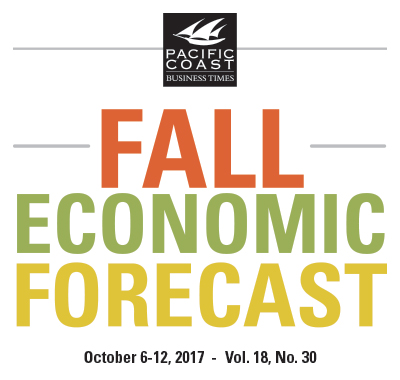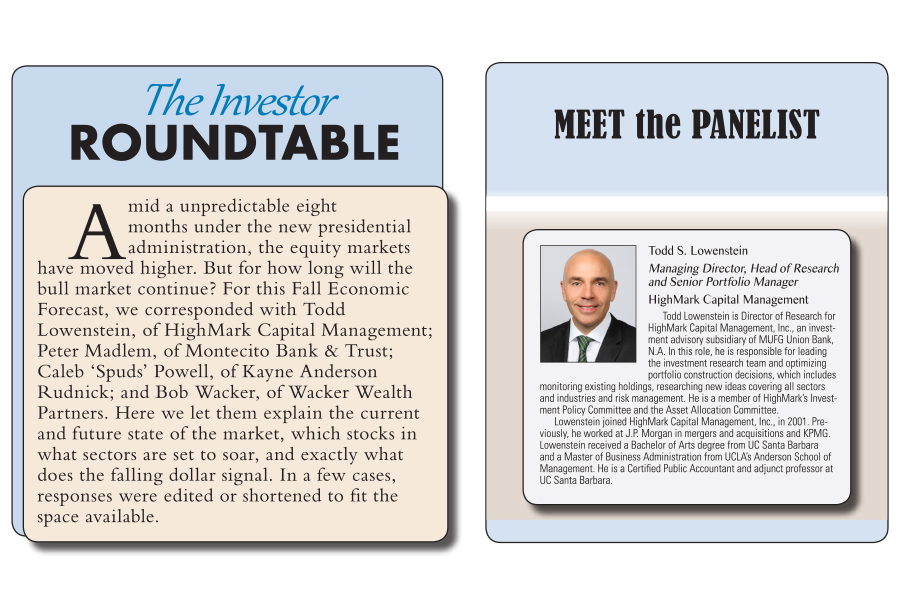By Chris Officer
Staff Writer
1) The equity markets have thrown us a significant curveball. We are fully priced for an earnings windfall in 2018, despite rising risks. What are you telling your clients to do?
• Lowenstein: Markets have been incredibly resilient in the face of unending policy uncertainty and geopolitical risks. Better global growth prospects and rebounding corporate earnings have supported risk assets recently after surmounting serious challenges faced in 2015 and 2016, namely the collapse in energy prices, rapid U.S. dollar appreciation and a technical earnings recession.
Today, the outlook is much improved with expectations of low double digit earnings growth this year and next and valuations, while stretched at the high end of the historic range, are more reasonable when compared to low yielding corporate bonds and treasuries. Return expectations are high, we believe markets have pulled forward returns this cycle and will moderate. There are warning signs to heed such as peak profits, margins and valuations. Good news is most cycles don’t die from old age and the pre-conditions for a garden variety recession are scarce. This expansion could last another 2-3 years. However, investors need to prepare for increased levels of volatility as market conditions normalize going forward, outperformance will hinge on being very selective, contrarian and take advantage of mispricing opportunities where they exist. That means rotating to areas of the market that look undervalued, carry low expectations, have improving fundamentals with compelling risk and reward profiles.
Inexplicably investors have become completely desensitized to bad news and event risk largely because of central bank conditioning. Today, risk seems underpriced and overlooked, markets only see blue skies ahead which may prove too optimistic. For example, the tense North Korea standoff warrants some caution, however, markets are indifferent at best and complacent at worst assigning low probability of an adverse outcome. We haven’t had a significant market correction in some time which would be a cathartic development shaking out built up excesses and weaker hands. Paradoxically, you want more volatility in the market, some caution is healthy, otherwise asset prices can become unhinged from reality . The market normally assigns some level of risk premium to assets to compensate for uncertainty and late cycle dynamics and yet increasingly it’s just not there.
This cycle has been unique in that everyone was a winner. Equities and bonds have positively correlated returns whereas had in past cycles they were mostly negatively correlated. Central banks unprecedented involvement have turned long-standing, textbook economic and financial market relationships upside down. We are transitioning from a liquidity driven market to a growth dependent market, as central bank policies diverge and stimulus unwinds we likely will experience more market turbulence and re-pricing of risk. It is important to stress there is always something to worry about, both seen and unforeseen risks. By structuring balanced asset allocations, proper diversification, and tactical positioning we can build an all-weather portfolio to prepare for most outcomes in our efforts to protect capital, maximize returns and minimize risks.
2) Are there any attractive sectors or stocks that you see? Banks, energy stocks and some utilities have certainly underperformed in the current market?
• Lowenstein: We have favored international and emerging markets over domestic markets and the cheaper cyclical, economically sensitive areas of the market rather than expensive defensives and yield plays. Attractive areas favored include Europe, Japan, finance, technology and energy. International market valuations are cheaper, benefiting from monetary stimulus, and earlier in their economic cycle recoveries with accelerating momentum. They are being driven by a pickup in global growth, recapitalized banks with flowing credit, as well as a visible recovery in global trade. With prospects for tax reform building, these areas of the market stand to benefit disproportionately.
3) What about that falling dollar? Is it a help to exporters or does it signal a global lack of confidence in the Trump administration and its policies, or maybe something else?
• Lowenstein: After an extended period dominance, where the dollar rose greater than 20 percent over a two-year period, it is now giving back some ground. This is primarily related to market disappointment in the pro-growth policy agenda where lack of success in health care repeal, uncertainty surrounding tax reform and general dysfunction seen in Washington is driving odds of legislative success lower. Equally important factors in dollar weakness are the significant revival of growth abroad in Europe, Japan and other emerging markets. This has caused a tsunami of capital flows out of the U.S. toward these markets, putting downward pressure on the dollar. A weaker dollar does benefit exporter competitiveness and multinational company earnings as favorable earnings translations lift overseas earnings prospects.
Markets still remain sanguine that positive fiscal and regulatory reforms will be under¬taken to remedy vexing issues surrounding health care, tax policy and counterproductive regulations. To the extent these efforts move forward, it could unshackle unnecessary burdens holding back our growth potential, lengthen the business cycle and drive higher corporate earnings power. Our early concern had been that markets became too optimistic on what could be accomplished. Expectations were ahead of political reality, yet markets haven’t fully recalibrated, still pricing in the some potential positives while overlooking inherent risks and tradeoffs involved.
4) Very few would have predicted a 2.1 yield on the 10-year Treasury after multiple Fed rate hikes and talk about shrinking the Fed balance sheet. What is going on in the debt markets and what do you tell aging baby boomers that are looking to bonds for safety and yield?
• Lowenstein: Bond yields largely reflect an economy devoid of traditional price inflation, recent data has turned down dramatically. At these level of yields, real returns on bonds just aren’t attractive and you aren’t being compensated for inherent risks and unexpected inflation. Moreover, spreads on credit are at historically tight levels reflecting complacency. Investors should guard against reaching for yield without considering the downside risks. Rather, building a laddered portfolio of intermediate term, high quality bonds affords investors time to capitalize on a higher rate climate in the future.
Why inflation and higher rates aren’t occurring late cycle with full employment has mystified central bankers. It’s incredible to think that despite expanding money supply, the velocity of money has slowed and inflation is nonexistent. Part of the problem is that these unconventional polices weren’t designed to be long term solutions but rather temporary in nature. Consequently, the longer QE has been in effect, the more it has diminished its efficacy and even made it potentially counterproductive. Persistently low global rates have driven the cost of capital too low and allowed overcapacity from the previous cycles to remain in force. This overinvestment never was rationalized, creative destruction didn’t occur because easy credit depressed prices.. There are many other secular explanations for lower inflation such as technological innovation, productivity improvements, low labor participation rates and a deflationary debt overhang.
So while traditional inflation measure are low, we do have plenty of asset price inflation engineered by coordinated efforts of central banks. Unconventional policies such as zero or negative rates and massive quantitative easing has proven to be an overwhelming tool, forcing investors out the risk curve inflating asset prices. At this point, simply continuing on the same accommodative path heightens risks and incentivizes risky behavior, poor capital allocation decisions, and potentially drives asset bubbles. It is hard to argue that their supersized role, not only as referee but as a player on the field, hasn’t distorted markets across the board. The main concern is we are witnessing some groupthink and herding behavior conditioned by warped central bank incentives.
5) Extra Credit: What is your forecast for the S&P 500 level and 10-year treasury interest rate at year’s end?
• Lowenstein: Our forecast for the S&P 500 is 2,550 at the high end the range and our 10 year yield is 2.5 percent at the midpoint estimate. The price range centers around our expectation for U.S. to return mid single digit returns. The rise in interest rates is taking longer than expected as the pace at which the ECB curtails QE and the pace at which the FOMC reduces their repurchasing program is advancing slower than expected.




